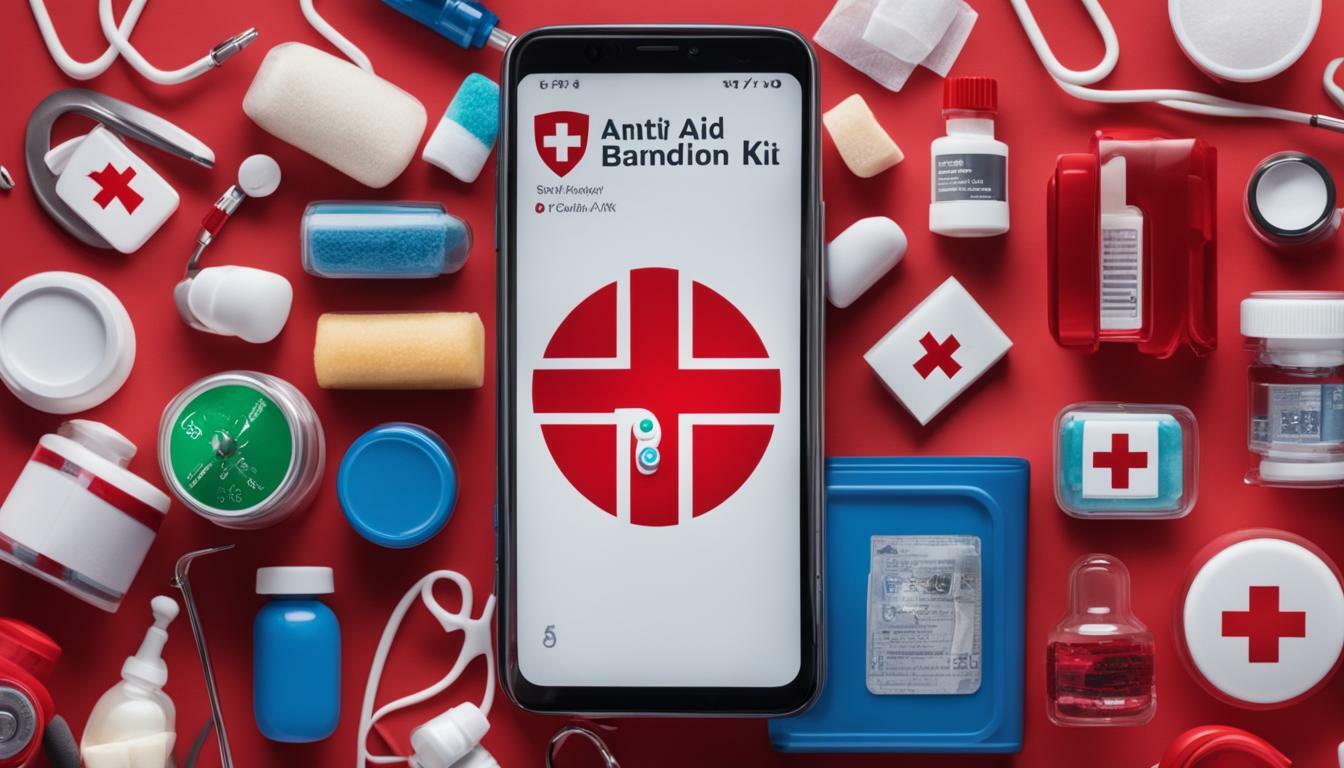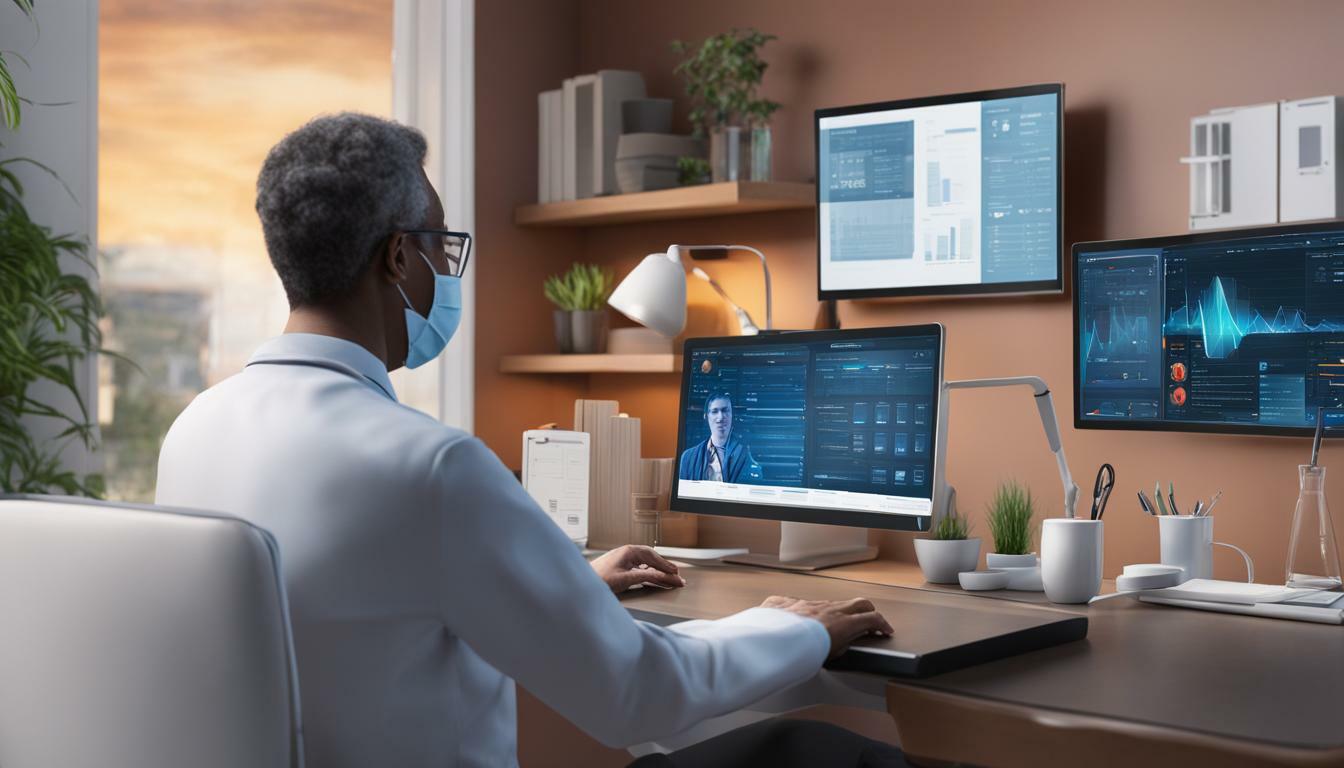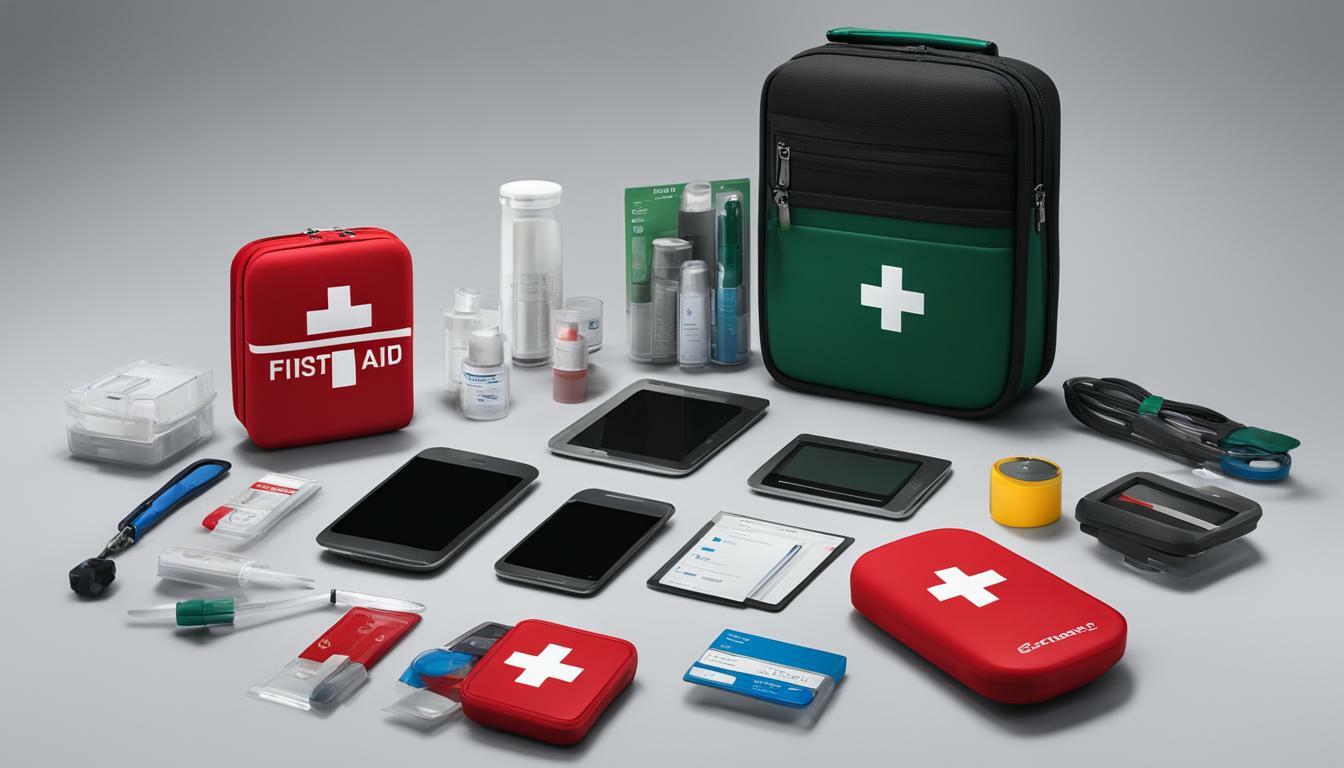In today’s age of digital innovation, the intersection of technology and health has paved the way for exciting developments, including the emergence of digital mini first aid kits. These innovative kits utilize digital tools and technologies to provide immediate assistance and guidance for basic first aid procedures. As technological advancements continue to shape the healthcare landscape, it is crucial to explore the potential of digital mini first aid kits in improving healthcare outcomes.
- Digital mini first aid kits leverage technology to provide immediate assistance in emergency situations.
- Technological advancements in healthcare, such as telemedicine and artificial intelligence, have revolutionized diagnosis and treatment.
- Efforts should be made to address digital exclusion and health inequalities to ensure equitable access to digital health initiatives.
- Inclusive and ethical development and implementation of digital health solutions are key for maximizing their benefits.
- Future trends in technology and health include wearable health devices, remote monitoring, and personalized medicine.
Harnessing Technology for Healthcare Improvements in the UK
The UK healthcare system is embracing technology as a means to drive improvements in patient care and outcomes. Digital solutions are playing a vital role in transforming healthcare delivery and enhancing efficiency. From telemedicine to digital health platforms, these technological advancements are revolutionizing the way healthcare services are provided in the country.
One significant area where technology is making a difference is in telemedicine. Through teleconsultations, patients can access healthcare professionals remotely, eliminating the need for physical visits and reducing waiting times. This is particularly beneficial for individuals in remote areas who may struggle with limited access to healthcare services. Telemedicine also enables healthcare providers to remotely monitor patients’ health conditions, allowing for early intervention and proactive management.
“The use of digital technology in healthcare is not just limited to telemedicine. Digital health platforms are being developed to provide a wide range of services, from health tracking and monitoring to digital therapeutics,” explains Dr. Sarah Williams, a leading expert in health technology. “These platforms empower individuals to take charge of their health and well-being, providing them with valuable information and resources.”
With the rapid advancement of health technology, the possibilities are endless. The integration of artificial intelligence (AI) in healthcare holds immense potential for improving diagnosis and treatment outcomes. AI-driven algorithms can analyze complex medical data, such as breast lesions and abdominal CT scans, with greater accuracy and efficiency than ever before. This can aid healthcare professionals in making more informed decisions and delivering personalized care.
| Benefits of Technology in Healthcare: | Challenges in the Adoption of Health Technology: |
|---|---|
|
|
Overcoming Barriers and Ensuring Inclusivity
While the advancements in technology have the potential to transform healthcare, it is crucial to address the challenges and ensure inclusivity. Efforts should be made to bridge the digital divide and provide equal access to digital health solutions for all individuals. This includes addressing issues related to digital exclusion, such as limited internet connectivity and lack of digital literacy.
Furthermore, data privacy and security must be prioritized to build trust in digital health solutions. Clear guidelines and regulations need to be established to protect patient information and ensure compliance with ethical standards. Collaboration between healthcare providers, technology developers, and policymakers is essential to create a robust framework that addresses these concerns.

“To fully harness the potential of technology in healthcare, it is imperative to invest in the training and upskilling of healthcare professionals,” asserts Dr. Williams. “By providing healthcare professionals with the necessary knowledge and skills, we can maximize the benefits of digital health solutions and ensure the delivery of high-quality care.”
In conclusion, the UK healthcare system is embracing technology to drive improvements in patient care and outcomes. From telemedicine to digital health platforms, technology is revolutionizing the way healthcare services are delivered. However, it is crucial to address the challenges and ensure inclusivity to fully leverage the potential of technology in healthcare. By overcoming barriers and collaborating across sectors, we can pave the way for a more efficient, accessible, and patient-centered healthcare system.
| Key Takeaways: |
|---|
|
The Role of Digital Mini First Aid Kits in Immediate Assistance
Digital mini first aid kits have emerged as a convenient and user-friendly solution for providing immediate assistance in emergency situations. These innovative kits leverage digital tools and technologies to guide users through basic first aid procedures, enabling them to take action quickly and confidently. From minor cuts and burns to more serious injuries, these kits equip individuals with the knowledge and resources to administer effective first aid before professional help arrives.
One of the key advantages of digital mini first aid kits is their accessibility. They are compact and portable, making them easy to carry in a backpack, purse, or glove compartment. With just a few taps on a smartphone or tablet, users can access step-by-step instructions, video tutorials, and interactive tools that offer guidance on how to handle a wide range of emergencies. This accessibility is particularly valuable in situations where time is of the essence and immediate action can make a critical difference.
These digital mini first aid kits also address a common challenge faced by many individuals during emergencies—the fear and uncertainty of not knowing how to respond. By providing clear instructions and visual demonstrations, they empower users to act confidently and effectively. The kits can also include features such as real-time emergency alerts, location-based emergency services, and automatic notification of nearby medical facilities, further enhancing their usefulness in urgent situations.
To illustrate the effectiveness of digital mini first aid kits, consider the following example: Imagine a hiker who sustains a deep cut while exploring a remote area. With limited access to medical assistance, the hiker can rely on a digital mini first aid kit to receive immediate guidance on wound care, including how to clean and dress the wound properly. The kit may also provide instructions on how to stop bleeding and manage pain until professional medical help can be sought. In this scenario, the digital mini first aid kit plays a crucial role in ensuring the hiker’s safety and well-being.
Providing Immediate Assistance with Digital Mini First Aid Kits
When it comes to emergency situations, every second counts. Digital mini first aid kits offer a practical solution to address this urgency. By harnessing the power of digital technology, these kits empower individuals to become immediate responders, assisting in the critical moments before professional medical help arrives.

| Advantages of Digital Mini First Aid Kits |
|---|
| Convenience and portability |
| Access to step-by-step instructions and video tutorials |
| Real-time emergency alerts and location-based emergency services |
| Automatic notification of nearby medical facilities |
While digital mini first aid kits are not a substitute for professional medical care, they play a vital role in bridging the gap between an emergency situation and the arrival of medical professionals. By facilitating quick and informed responses, these kits have the potential to save lives and minimize the severity of injuries.
The intersection of technology and health has introduced new possibilities for immediate assistance in emergency situations. Digital mini first aid kits are a testament to the transformative impact of technology in healthcare. As these kits continue to evolve, incorporating advancements such as AI-driven algorithms and real-time monitoring capabilities, they promise to revolutionize the way we respond to emergencies and ensure the well-being of individuals in times of need.
Telemedicine: Revolutionizing Diagnosis and Management of Health Conditions
Telemedicine has emerged as a game-changer in healthcare, revolutionizing the way health conditions are diagnosed and managed. Through the use of digital technologies, patients can now access medical consultations and receive care remotely, eliminating the need for in-person visits and reducing the burden on healthcare systems. This has proven particularly impactful in addressing challenges such as surgical site infections and trauma patients, where timely intervention is crucial for positive outcomes.
One area where telemedicine has been successful is in the diagnosis of health conditions. With the aid of telemedicine platforms, healthcare professionals can remotely assess patients’ symptoms and provide accurate diagnoses, often in real-time. This has significant implications for individuals in remote or underserved areas, who may not have easy access to specialized medical expertise.
Furthermore, telemedicine is transforming the management of health conditions. Through remote monitoring and virtual follow-up appointments, patients can receive personalized care plans and ongoing support without the need for frequent visits to healthcare facilities. This not only improves convenience and accessibility but also enables early detection of potential complications, leading to better health outcomes.
| Benefits of Telemedicine | Challenges of Telemedicine |
|---|---|
| 1. Improved access to healthcare for remote and underserved populations | 1. Limited access to digital technologies for some individuals |
| 2. Reduced healthcare costs and travel expenses | 2. Concerns regarding the security and privacy of patient data |
| 3. Enhanced patient convenience and flexibility | 3. Technical difficulties and connectivity issues |
Telemedicine has the potential to bridge the gap between patients and healthcare providers, revolutionizing the way healthcare is delivered. By leveraging technology, patients can receive timely medical advice, diagnosis, and ongoing management of their health conditions, regardless of their geographical location. However, it is important to address the challenges associated with telemedicine to ensure equitable access for all individuals.
The Future of Telemedicine
The future of telemedicine holds immense potential for further advancements in healthcare. As technology continues to evolve, we can expect to see innovations such as wearable health devices for remote monitoring, AI-powered diagnostic tools, and personalized medicine solutions tailored to individual needs. These developments have the potential to enhance patient outcomes, improve healthcare efficiency, and further bridge the gap in access to quality healthcare.
It is crucial that policymakers, healthcare providers, and technology developers collaborate to address the ethical considerations surrounding telemedicine. This includes ensuring data privacy, maintaining patient consent, and implementing responsible AI practices. By upholding high ethical standards, we can maximize the benefits of telemedicine while safeguarding patient rights and welfare.

In conclusion, telemedicine is revolutionizing the diagnosis and management of health conditions. By leveraging digital technologies, telemedicine is improving access to healthcare, enhancing patient convenience, and enabling timely interventions. While there are challenges to overcome, the future of telemedicine looks promising, with the potential to revolutionize healthcare delivery and provide equitable access to quality care for all.
Artificial Intelligence in Medicine: Enhancing Diagnosis and Treatment
Artificial intelligence is transforming the field of medicine, empowering healthcare professionals with advanced tools for accurate diagnosis and treatment. The integration of AI technologies in healthcare has opened new avenues for improving patient outcomes and optimizing healthcare delivery. From detecting breast lesions to analyzing abdominal CT scans, AI-driven tools are revolutionizing the way medical conditions are diagnosed and managed.
AI algorithms have shown remarkable accuracy in the detection of breast lesions, aiding radiologists in identifying potential abnormalities and reducing the risk of misdiagnosis. These algorithms analyze mammography images, highlighting suspicious areas and assisting in the early detection of breast cancer. By leveraging the power of AI, healthcare professionals can detect and treat breast lesions more efficiently, leading to improved patient outcomes and survival rates.
Abdominal CT scans are another area where AI is making a significant impact. With its ability to analyze large volumes of medical imaging data, AI algorithms can assist radiologists in identifying and characterizing abdominal abnormalities, such as tumors or cysts. This not only speeds up the diagnostic process but also helps in determining the most appropriate treatment options for patients.
Nevertheless, as AI continues to transform healthcare, it is crucial to consider the ethical implications and ensure that these technologies are implemented responsibly. The responsible use of AI in medicine requires safeguarding patient privacy and data security, as well as maintaining a transparent and accountable approach. By addressing these ethical considerations and leveraging the potential of AI, healthcare professionals can continue to enhance diagnosis and treatment, ultimately improving patient care.

| Application | Description |
|---|---|
| Breast Lesion Detection | AI algorithms aid in the accurate detection and characterization of breast lesions, assisting radiologists in early diagnosis. |
| Abdominal CT Scan Analysis | AI technologies analyze abdominal CT scans, assisting radiologists in identifying and characterizing abnormalities. |
| Diagnostic Decision Support | AI systems provide healthcare professionals with real-time clinical decision support, improving diagnostic accuracy and treatment planning. |
| Personalized Medicine | AI algorithms analyze patient data to tailor treatment plans and interventions based on individual characteristics and needs. |
Addressing Digital Exclusion and Health Inequalities
While technology holds immense potential for healthcare improvements, it is crucial to address the issue of digital exclusion and health inequalities to ensure that no one is left behind. In an increasingly digital age, access to and utilization of digital technologies in healthcare can significantly impact health outcomes and overall well-being. However, certain population groups, such as the elderly, low-income individuals, and those in rural areas, may face barriers that prevent them from benefiting from these advancements.
Digital exclusion refers to the gap between those who have access to and can effectively use digital technologies, and those who do not. This exclusion can exacerbate existing health inequalities, as individuals who lack access to digital resources may be deprived of vital health information, telemedicine services, and other digital health solutions. Furthermore, individuals without digital literacy skills may struggle to navigate digital platforms or understand the information provided, further widening the gap in healthcare access and outcomes.
To bridge this digital divide, it is essential to implement policies and initiatives that promote digital inclusion and address health inequalities. This can be achieved through various strategies, such as improving digital infrastructure and connectivity in underserved areas, providing digital literacy training programs, and developing user-friendly interfaces for digital health solutions. Collaborative efforts between healthcare providers, policymakers, and technology developers are crucial to ensure that digital technologies are designed with inclusivity in mind.

Table 1: Factors Contributing to Digital Exclusion and Health Inequalities
| Factors | Impact on Digital Inclusion |
|---|---|
| Lack of access to digital devices | Prevents individuals from utilizing digital health technologies |
| Limited internet connectivity | Hinders access to online health resources and telemedicine services |
| Low digital literacy | Makes it difficult to navigate digital platforms and understand health information |
| Language and cultural barriers | Can impede effective communication and engagement with digital health solutions |
| Socioeconomic status | Higher-income individuals may have greater access to digital resources and healthcare services |
Efforts to address digital exclusion and health inequalities not only promote equity in healthcare but also enhance overall healthcare outcomes. By ensuring that digital health initiatives are inclusive and accessible to all, we can harness the true potential of technology in improving healthcare delivery, empowering individuals, and ultimately creating a healthier society.
Overcoming Barriers to Access and Use of Digital Technologies
To fully harness the potential of digital technologies in healthcare, it is essential to overcome barriers that prevent individuals from accessing and effectively utilizing these tools. In today’s digital age, where technology plays a crucial role in improving healthcare outcomes, it is crucial to ensure that everyone has equal access to digital health solutions.
Digital exclusion, which refers to the lack of access to digital technologies, can exacerbate existing health inequalities. Certain populations, such as elderly individuals or those living in rural areas, may face challenges in accessing and using digital health tools. This can result in disparities in healthcare access and outcomes.
To address these barriers, it is important to focus on enhancing digital literacy among all individuals, regardless of age or location. By providing education and training on using digital technologies for healthcare, we can empower individuals to navigate digital platforms and make informed decisions about their health.
Infrastructure development is another key aspect of overcoming barriers to digital health access. Ensuring that robust internet connectivity and reliable technology infrastructure are available in all areas is essential for enabling widespread adoption of digital health solutions. This includes investing in the development of telecommunication networks and expanding access to high-speed internet.
In addition, user-friendly interfaces and intuitive designs are crucial for making digital health tools accessible to individuals with varying levels of technological proficiency. By prioritizing user experience and designing interfaces that cater to diverse user needs, we can create inclusive digital health solutions that are easy to navigate and understand.

Table: Strategies for Overcoming Barriers to Access and Use of Digital Technologies
| Strategy | Explanation |
|---|---|
| Digital literacy initiatives | Provide education and training on using digital technologies for healthcare to empower individuals to navigate digital platforms and make informed decisions about their health. |
| Infrastructure development | Invest in the development of telecommunication networks and expand access to high-speed internet to ensure robust connectivity in all areas. |
| User-friendly interfaces | Prioritize user experience and design interfaces that cater to diverse user needs, making digital health tools easy to navigate and understand. |
By addressing these barriers and promoting inclusive digital health initiatives, we can ensure that everyone has equal access to the benefits of digital technologies in healthcare. This will not only improve healthcare outcomes but also contribute to reducing health inequalities and creating a more equitable healthcare system.
Promoting Inclusive Digital Health Initiatives
Inclusive digital health initiatives are crucial for bridging the gap between technology and healthcare, ensuring that everyone can benefit from the advancements in health technology. While digital solutions have the potential to revolutionize healthcare, it is important to consider the potential barriers that certain populations may face in accessing and using these technologies. By addressing these barriers, we can create a more inclusive healthcare system that leaves no one behind.
One key barrier to consider is digital exclusion, where individuals lack access to or familiarity with digital technologies. This can be particularly detrimental for marginalized communities or those in remote or underserved areas. Efforts should be made to improve digital literacy and provide access to digital devices and internet connectivity. Investing in infrastructure development, such as broadband expansion, can also help bridge the digital divide and ensure that digital health initiatives are accessible to all.
Another challenge in promoting inclusive digital health initiatives is ensuring that the technology is user-friendly and culturally sensitive. User-centered design principles should be applied to create interfaces that are intuitive and easy to navigate, even for individuals with limited technical expertise. Additionally, cultural considerations should be taken into account to ensure that digital health solutions are culturally appropriate and inclusive of diverse populations.
An essential aspect of promoting inclusive digital health initiatives is the involvement of all stakeholders, including healthcare providers, policymakers, and technology developers. Collaboration and partnerships are crucial for designing and implementing digital solutions that meet the needs of different communities and address health disparities. By working together, we can create a healthcare system that embraces technology while leaving no one behind.
| Benefits of Inclusive Digital Health Initiatives | Challenges in Promoting Inclusivity |
|---|---|
|
|
“Promoting inclusivity in digital health is not just a matter of technology, but also a matter of social equity and justice. We must strive to ensure that technological advancements benefit all individuals, regardless of their socioeconomic status, geographic location, or cultural background.” – Dr. Sarah Thompson, Digital Health Advocate
The Impact of Digital Mini First Aid Kits in Emergency Situations
In emergency situations, digital mini first aid kits can make a critical difference, empowering individuals to provide immediate and effective assistance. These compact kits are equipped with digital tools and technologies that guide users through basic first aid procedures, offering step-by-step instructions and real-time feedback to ensure proper care.
One of the key advantages of digital mini first aid kits is their accessibility. They are portable and can be easily carried in pockets, purses, or backpacks, allowing individuals to have essential first aid resources readily available wherever they go. Whether it’s a minor cut, a burn, or a sudden injury, these kits provide users with the knowledge and tools they need to administer initial care before professional help arrives.
Additionally, digital mini first aid kits often include features such as built-in sensors and connectivity to emergency services. This enables them to detect vital signs and automatically send an alert to emergency responders in critical situations. The combination of digital guidance and real-time communication can significantly improve the chances of a positive outcome, especially when quick action is crucial.
By empowering individuals to take immediate action during emergencies, digital mini first aid kits have the potential to save lives and minimize the severity of injuries. Their user-friendly interfaces and intuitive design make them suitable for people of various skill levels, ensuring that even those without extensive medical training can provide valuable assistance when needed.
| Benefits of Digital Mini First Aid Kits: |
|---|
| Immediate access to vital first aid information and instructions |
| Compact and portable, allowing for easy carrying and accessibility |
| Real-time feedback and guidance for proper first aid procedures |
| Integration with sensors and emergency services, enabling rapid response |
| User-friendly interfaces suitable for individuals with varying skill levels |

“In emergency situations, every second counts. Digital mini first aid kits provide individuals with the tools and knowledge to take immediate action, potentially saving lives and reducing the impact of injuries.” – Dr. Sophie Thompson, Emergency Medicine Specialist
Future Trends in Technology and Health
The future of technology and health holds immense promise, with advancements in wearable devices, remote monitoring, and personalized medicine poised to revolutionize healthcare even further. Wearable health devices, such as smartwatches and fitness trackers, have already become popular among individuals seeking to monitor their health and track their fitness goals. These devices provide real-time data on heart rate, sleep patterns, and activity levels, empowering individuals to take a proactive approach to their well-being.
Remote monitoring is another area that holds great potential. Through the use of digital health platforms and connected devices, healthcare providers can remotely monitor patients’ vital signs, medication adherence, and disease progression. This not only allows for more personalized and timely interventions but also reduces the need for frequent hospital visits, particularly for patients with chronic conditions.
Personalized medicine, enabled by advancements in genomics and AI, is set to transform the way healthcare is delivered. With the ability to analyze an individual’s genetic makeup, healthcare providers can tailor treatments based on a patient’s unique genetic profile, resulting in more targeted and effective interventions. Furthermore, AI-driven algorithms can assist in the early detection and prediction of diseases, improving outcomes and potentially saving lives.

As healthcare continues to embrace technology, it is crucial to address the challenges and considerations that come with it. Ethical questions surrounding data privacy, consent, and the responsible use of AI must be carefully navigated to ensure the trust and confidence of both patients and healthcare professionals. Additionally, efforts should be made to bridge the digital divide and ensure that all individuals, regardless of socioeconomic status or geographic location, have access to and can benefit from these technological advancements. Collaboration between healthcare providers, policymakers, and technology developers is essential to drive forward inclusive and ethical digital health initiatives.
| Advancements in Technology and Health | Benefits |
|---|---|
| Wearable Devices | Real-time monitoring of vital signs and fitness goals |
| Remote Monitoring | Personalized interventions and reduced hospital visits |
| Personalized Medicine | Tailored treatments based on genetic profile and early disease detection |
In conclusion, the intersection of technology and health holds great promise for the future of healthcare. Advancements in wearable devices, remote monitoring, and personalized medicine are set to revolutionize the way we approach and deliver healthcare. However, it is important to address ethical considerations, promote inclusivity, and ensure equitable access to these technologies to maximize their potential benefits for all individuals.
Ethical Considerations in the Intersection of Technology and Health
As technology continues to shape the landscape of healthcare, ethical considerations play a crucial role in ensuring the responsible and ethical use of digital health technologies. The growing reliance on digital solutions, such as telemedicine and artificial intelligence, raises important questions about privacy, consent, and algorithmic bias.
One of the key ethical challenges is maintaining patient privacy and data security. With the increasing use of digital health technologies, vast amounts of personal health data are being generated and stored. It is essential that healthcare providers and technology developers implement robust measures to protect this sensitive information and adhere to strict data privacy regulations.
“The intersection of technology and health brings immense possibilities for improving patient care, but it also poses ethical dilemmas that need to be carefully navigated.”
Consent is another crucial ethical consideration. Patients must have a clear understanding of how their data will be used and shared when engaging with digital health technologies. Informed consent should be obtained, and individuals should have the right to opt out or withdraw their consent at any time. Transparent communication and patient education are essential in building trust and ensuring that individuals can make informed decisions about their healthcare data.
Algorithmic bias is a pressing issue in the use of artificial intelligence in healthcare. Biased algorithms can perpetuate existing health disparities, leading to unequal access to care and unequal treatment outcomes. It is imperative to develop AI models that are trained on diverse datasets and regularly monitored for biases. Additionally, mechanisms should be put in place to ensure that decision-making processes involving AI are transparent and accountable.
Table: Ethical Considerations in Technology and Health
| Key Ethical Considerations | Implications |
|---|---|
| Data privacy and security | Protecting personal health information and complying with data privacy regulations. |
| Consent | Obtaining informed consent from patients regarding the use and sharing of their healthcare data. |
| Algorithmic bias | Ensuring that AI models are trained on diverse datasets and monitored for biases to prevent unequal treatment outcomes. |
The intersection of technology and health brings immense possibilities for improving patient care, but it also poses ethical dilemmas that need to be carefully navigated. By addressing these ethical considerations and incorporating principles of transparency, accountability, and inclusivity, we can harness the power of technology to enhance healthcare outcomes while safeguarding patient welfare.

The intersection of technology and health, exemplified by digital mini first aid kits, holds immense potential for improving healthcare outcomes. These kits utilize digital tools and technologies to provide immediate assistance and guidance for basic first aid procedures, empowering individuals to respond effectively in emergencies.
However, as we embrace the benefits of technology in healthcare, it is crucial to prioritize inclusivity and ethics. Efforts should be made to address potential barriers to accessing and using digital technologies, ensuring that all individuals, regardless of their backgrounds or socioeconomic status, can benefit from these advancements.
Technological advancements, such as telemedicine and artificial intelligence, have already shown promise in revolutionizing the diagnosis and management of health conditions. From the remote consultations made possible by telemedicine to the AI-driven tools that aid in detecting breast lesions and analyzing CT scans, these innovations are transforming healthcare delivery.
While embracing the potential of technology, it is essential to consider the potential impact on digital exclusion and health inequalities. Collaborative efforts between healthcare providers, policymakers, and technology developers are necessary to address these challenges and promote inclusive digital health initiatives.
In conclusion, as we continue to advance in technology and healthcare, it is crucial to ensure that the development and implementation of technological advancements prioritize inclusivity and ethics. By doing so, we can harness the full potential of digital mini first aid kits and other technological solutions to improve healthcare outcomes for all individuals.
